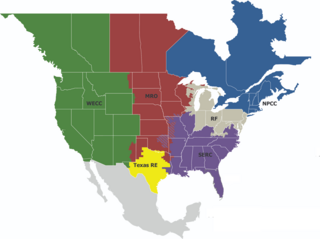Related Research Articles

The North American Electric Reliability Corporation (NERC) is a nonprofit corporation based in Atlanta, Georgia, and formed on March 28, 2006, as the successor to the North American Electric Reliability Council. The original NERC was formed on June 1, 1968, by the electric utility industry to promote the reliability and adequacy of bulk power transmission in the electric utility systems of North America. NERC's mission states that it "is to assure the effective and efficient reduction of risks to the reliability and security of the grid".
In a broad sense, an electricity market is a system that facilitates the exchange of electricity-related goods and services.

The Electric Reliability Council of Texas, Inc. (ERCOT) is an American organization that operates Texas's electrical grid, the Texas Interconnection, which supplies power to more than 25 million Texas customers and represents 90 percent of the state's electric load. ERCOT is the first independent system operator (ISO) in the United States. ERCOT works with the Texas Reliability Entity (TRE), one of six regional entities within the North American Electric Reliability Corporation (NERC) that coordinate to improve reliability of the bulk power grid.

A regional transmission organization (RTO) in the United States is an electric power transmission system operator (TSO) that coordinates, controls, and monitors a multi-state electric grid. The transfer of electricity between states is considered interstate commerce, and electric grids spanning multiple states are therefore regulated by the Federal Energy Regulatory Commission (FERC). The voluntary creation of RTOs was initiated by FERC Order No. 2000, issued on December 20, 1999. The purpose of the RTO is to promote economic efficiency, reliability, and non-discriminatory practices while reducing government oversight.

The Texas Interconnection is an alternating current (AC) power grid – a wide area synchronous grid – that covers most of the state of Texas. The grid is managed by the Electric Reliability Council of Texas (ERCOT).

PJM Interconnection LLC (PJM) is a regional transmission organization (RTO) in the United States. It is part of the Eastern Interconnection grid operating an electric transmission system serving all or parts of Delaware, Illinois, Indiana, Kentucky, Maryland, Michigan, New Jersey, North Carolina, Ohio, Pennsylvania, Tennessee, Virginia, West Virginia, and the District of Columbia.
There is a large array of stakeholders that provide services through electricity generation, transmission, distribution and marketing for industrial, commercial, public and residential customers in the United States. It also includes many public institutions that regulate the sector. In 1996, there were 3,195 electric utilities in the United States, of which fewer than 1,000 were engaged in power generation. This leaves a large number of mostly smaller utilities engaged only in power distribution. There were also 65 power marketers. Of all utilities, 2,020 were publicly owned, 932 were rural electric cooperatives, and 243 were investor-owned utilities. The electricity transmission network is controlled by Independent System Operators or Regional Transmission Organizations, which are not-for-profit organizations that are obliged to provide indiscriminate access to various suppliers to promote competition.

Variable renewable energy (VRE) or intermittent renewable energy sources (IRES) are renewable energy sources that are not dispatchable due to their fluctuating nature, such as wind power and solar power, as opposed to controllable renewable energy sources, such as dammed hydroelectricity or biomass, or relatively constant sources, such as geothermal power.

Energy in California is a major area of the economy of California. California is the state with the largest population and the largest economy in the United States. It is second in energy consumption after Texas. As of 2018, per capita consumption was the fourth-lowest in the United States partially because of the mild climate and energy efficiency programs.

The California Independent System Operator (CAISO) is a non-profit Independent System Operator (ISO) serving California. It oversees the operation of California's bulk electric power system, transmission lines, and electricity market generated and transmitted by its member utilities. CAISO is one of the largest ISOs in the world, delivering 300 million megawatt-hours of electricity each year and managing about 80% of California's electric flow.

The electrical power grid that powers Northern America is not a single grid, but is instead divided into multiple wide area synchronous grids. The Eastern Interconnection and the Western Interconnection are the largest. Three other regions include the Texas Interconnection, the Quebec Interconnection, and the Alaska Interconnection. Each region delivers power at a nominal 60 Hz frequency. The regions are not usually directly connected or synchronized to each other, but there exist some HVDC interconnectors. The Eastern and Western grids are connected via seven links that allow 1.32 GW to flow between them. A study by the National Renewable Energy Laboratory found that increasing these interconnections would save energy costs.
Capacity credit is the fraction of the installed capacity of a power plant which can be relied upon at a given time, frequently expressed as a percentage of the nameplate capacity. A conventional (dispatchable) power plant can typically provide the electricity at full power as long as it has a sufficient amount of fuel and is operational, therefore the capacity credit of such a plant is close to 100%; it is exactly 100% for some definitions of the capacity credit. The output of a variable renewable energy (VRE) plant depends on the state of an uncontrolled natural resource, therefore a mechanically and electrically sound VRE plant might not be able to generate at the rated capacity when needed, so its CC is much lower than 100%. The capacity credit is useful for a rough estimate of the firm power a system with weather-dependent generation can reliably provide. For example, with a low, but realistic wind power capacity credit of 5%, 20 gigawatts (GW) worth of wind power needs to be added to the system in order to permanently retire a 1 GW fossil fuel plant while keeping the electrical grid reliability at the same level.
Reliability index is an attempt to quantitatively assess the reliability of a system using a single numerical value. The set of reliability indices varies depending on the field of engineering, multiple different indices may be used to characterize a single system. In the simple case of an object that cannot be used or repaired once it fails, a useful index is the mean time to failure representing an expectation of the object's service lifetime. Another cross-disciplinary index is forced outage rate (FOR), a probability that a particular type of a device is out of order. Reliability indices are extensively used in the modern electricity regulation.
Loss of load in an electrical grid is a term used to describe the situation when the available generation capacity is less than the system load. Multiple probabilistic reliability indices for the generation systems are using loss of load in their definitions, with the more popular being Loss of Load Probability (LOLP) that characterizes a probability of a loss of load occurring within a year. Loss of load events are calculated before the mitigating actions are taken, so a loss of load does not necessarily cause a blackout.
A load pocket is an area of electric grid that has limited ability to import electricity due to either very high concentration of demand or insufficient transmission capabilities and therefore cannot be entirely provided with power without participation of local electricity generation providers. A typical load pocket includes a major city. Load pocket's existence usually indicates difficulties with building of either new generation or new transmission, or both due to the area constraints or political pressure and despite the pocket being an attractive place for investment. The load pockets represent a problem for the deregulated electricity markets, as in the absence of regulation the captive customers are forced to accept the prices set by the local providers.
Power system operations is a term used in electricity generation to describe the process of decision-making on the timescale from one day to minutes prior to the power delivery. The term power system control describes actions taken in response to unplanned disturbances in order to provide reliable electric supply of acceptable quality. The corresponding engineering branch is called Power System Operations and Control. Electricity is hard to store, so at any moment the supply (generation) shall be balanced with demand. In an electrical grid the task of real-time balancing is performed by a regional-based control center, run by an electric utility in the traditional electricity market. In the restructured North American power transmission grid, these centers belong to balancing authorities numbered 74 in 2016, the entities responsible for operations are also called independent system operators, transmission system operators. The other form of balancing resources of multiple power plants is a power pool. The balancing authorities are overseen by reliability coordinators.
A balancing authority (BA) is an entity in the US electric system that is responsible for grid balancing: resource planning and unit commitment ahead of time, maintenance of the load-interchange-generation balance within a balancing authority area and support for real-time load-frequency control. The balancing authorities are connected by metered high-voltage tie lines and grouped into interconnections:
Load serving entity (LSE) in a deregulated electricity market is a company or government agency that is obligated by law or via a long-term contract to provide electrical power to end-users. The term is used in regulation, yet is vague and thus subject to prolonged political wrangling. For example, the US law defines an LSE as an obligation-bound provider of electricity directly to consumers or to a utility that serves the consumers. FERC defines the LSE as "any entity, including a load aggregator or power marketer, that serves end-users within a control area and has been granted the authority or has an obligation pursuant to state or local law, regulation, or franchise to sell electric energy to end-users located within the control area".
The power system reliability is the probability of a normal operation of the electrical grid at a given time. Reliability indices characterize the ability of the electrical system to supply customers with electricity as needed by measuring the frequency, duration, and scale of supply interruptions. Traditionally two interdependent components of the power system reliability are considered:
References
- 1 2 3 Tezak 2005, p. 2.
- ↑ PJM 2021, p. 13.
- ↑ Pechman 1993, p. 77.
- ↑ NERC. "M-1 Reserve Margin". nerc.com. North American Electric Reliability Corporation . Retrieved 10 April 2023.
- 1 2 NERC 2013, p. 3.
- ↑ Aagaard & Kleit 2022, p. 89.
- ↑ Aagaard & Kleit 2022, p. 86.
- ↑ Tezak 2005, pp. 2–3.
- 1 2 3 Wolak 2021, p. 7.
- ↑ Wolak 2021, p. 8.
- ↑ Wolak 2021, p. 9.
- ↑ Wolak 2021, p. 10.
- 1 2 Wolak 2021, p. 2.
- ↑ Wolak 2021, p. 4.
- ↑ Tezak 2005, p. 3.
- 1 2 Wolak 2021, p. 6.
- ↑ Wolak 2021, pp. 5–6.
- ↑ Wolak 2021, p. 5.